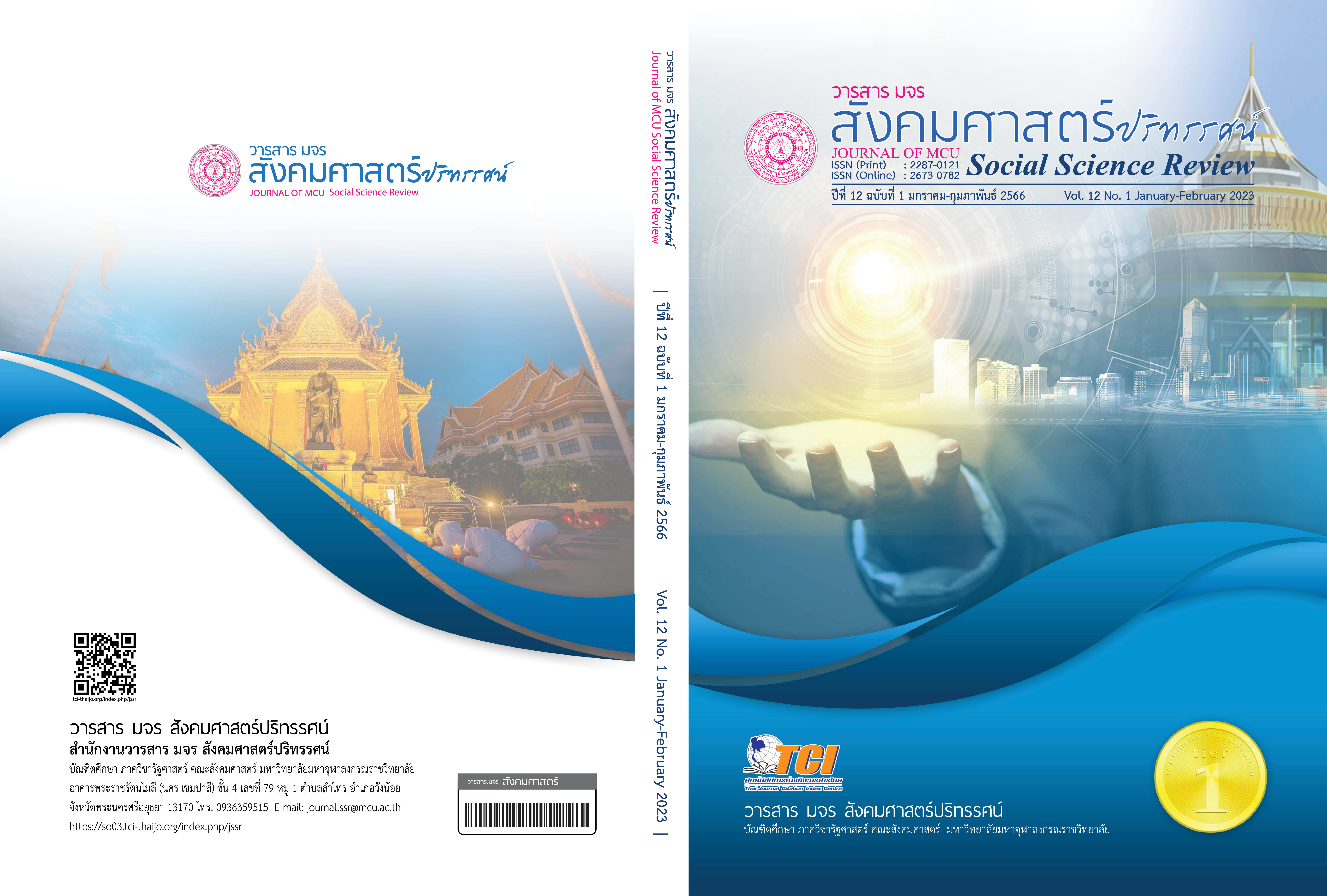การพัฒนาแผนการจัดการเรียนรู้ เรื่อง น้ำหนัก ตามกระบวนการ KYOZAI KENKYU ของนักเรียนชั้นประถมศึกษาปีที่ 3
คำสำคัญ:
แผนการจัดการเรียนรู้, กระบวนการ Kyozai Kenkyu, น้ำหนักบทคัดย่อ
บทความวิจัยนี้มีวัตถุประสงค์เพื่อพัฒนาแผนการจัดการเรียนรู้ที่ผ่านกระบวนการทำ Kyozai Kenkyu โดยใช้การศึกษาชั้นเรียนและวิธีการแบบเปิด ชั้นประถมศึกษาปีที่ 3 โดยใช้ระเบียบวิธีวิจัยเชิงคุณภาพที่เน้นการวิเคราะห์โพรโทคอลและการบรรยายเชิงวิเคราะห์ กลุ่มเป้าหมายคือ นักเรียนที่เข้าร่วมกิจกรรมการเปิดชั้นเรียนจำนวน 4 กลุ่ม โดยใช้วิธีการสุ่มแบบบังเอิญ เครื่องมือที่ใช้คือ แผนการจัดการเรียนรู้ เครื่องบันทึกวิดีทัศน์ เครื่องบันทึกเสียง และเครื่องบันทึกภาพนิ่ง โดยวิเคราะห์ข้อมูลตามวงจรของการศึกษาชั้นเรียน ทั้งหมด 4 ครั้ง เพื่อพัฒนาแผนการจัดการเรียนรู้ที่ได้จากกระบวนการทำ Kyozai Kenkyu ตามกรอบแนวคิดของไมตรี อินทร์ประสิทธิ์
ผลการวิจัยพบว่า แผนการจัดการเรียนรู้ถูกพัฒนาอย่างต่อเนื่องโดย วงจรที่ 1 สื่อที่ใช้วัดน้ำหนัก (คานไม้) และใบกิจกรรมยังมีความไม่ชัดเจน ส่งผลให้เกิดความยุ่งยากในการแสดงแนวคิดของนักเรียน วงจรที่ 2 ใบกิจกรรมมีความน่าสนใจมากขึ้น ส่งผลให้นักเรียนกล้าแสดงแนวคิด หลังจากมีการปรับสื่อที่ใช้วัดน้ำหนัก ยังคงทำให้แนวคิดของนักเรียนที่แสดงออกมาไม่ชัดเจน วงจรที่ 3 นักเรียนสามารถให้เหตุผลประกอบแนวคิดของตนเองชัดเจนมากขึ้นหลังจากใช้คาดวัดน้ำหนัก แต่พบว่า ยังคงมีความไม่แข็งแรง ส่งผลให้นักเรียนใช้คานลำบากและเสร็จไม่ทันเวลา วงจรที่ 4 เปลี่ยนจากคานไม้เป็นเหล็ก ส่งผลให้กระชับเวลาในการแขวน นักเรียนมีเวลาในการคิดและให้เหตุผลมากขึ้น นำไปสู่เป้าหมายของแผนการจัดการเรียนรู้เรื่อง น้ำหนัก
เอกสารอ้างอิง
กระทรวงศึกษาธิการ. (2551). หลักสูตรแกนกลางการศึกษาขั้นพื้นฐาน พุทธศักราช 2551.กรุงเทพฯ: ชุมนุมสหกรณ์การเกษตรแห่งประเทศไทย.
ไมตรี อินทร์ประสิทธิ์. (2557). กระบวนการแก้ปัญหาในปัญหาคณิตศาสตร์ระดับโรงเรียน. ขอนแก่น: เพ็ญพรินติ้ง จำกัด.
_______. (2560). เอกสารประกอบการอบรมเชิงปฏิบัติการสำหรับบุคลากรทาง การศึกษา ภายใต้โครงการแก้ไขปัญหาสาธารณสุขและการศึกษาในภาคตะวันออกเฉียงเหนือเพื่อลดความเหลื่อมล้ำทางสังคม. วันที่ 5 สิงหาคม 2560 ณ โรงแรมเดอะวัน บึงกาฬ.
_______. (2561). การศึกษาชั้นเรียนด้วยวิธีการแบบเปิด: PLC ภาคปฏิบัติจริงใ โรงเรียน (Open approach Lesson Study: An Authentic PLC Practice in School). เอกสารประกอบการอบรมเรื่องกิจกรรมเปิดชั้นเรียนระดับชาติ ครั้งที่ 12; 24-25 มีนาคม 2561; ขอนแก่น.
_______. (2562). การเขียนแผนการจัดการเรียนรู้ตามแนวทาง KYOZAI KENKYU ในการใช้ “การศึกษาชั้นเรียน” และ“วิธีการแบบเปิด” เพื่อยกระดับคุณภาพการศึกษาอย่างต่อเนื่อง. เอกสารประกอบการบรรยายการอบรมเชิงปฏิบัติการสำหรับครูด้วยนวัตกรรมการศึกษาชั้นเรียน (Lesson Study) และวิธีการแบบเปิด (Open Approach) เพื่อยกระดับคุณภาพการศึกษาอย่างต่อเนื่อง ภายใต้โครงการพัฒนาครูและโรงเรียนเพื่อยกระดับคุณภาพการศึกษาอย่างต่อเนื่อง สนับสนุนโดยกองทุนเพื่อความเสมอภาคทางการศึกษา (กสศ.). ณ สถาบันวิจัยและพัฒนาวิชาชีพครูสำหรับอาเซียน, ศูนย์วิจัยคณิตศาสตรศึกษา มหาวิทยาลัยขอนแก่น.
วิจารณ์ พานิช. (2555). วิถีสร้างการเรียนรู้เพื่อศิษย์ในศตวรรษที่ 21. กรุงเทพฯ: มูลนิธิสด ศรีสฤษดิ์วงศ์.
Baba, T. (2007). Japanese Education and Lesson Study: An Overview. In M. Isoda, M. Stephen, Y. Ohara & T. Miyakawa (Eds.). Japanese Lesson Study in Mathematics: Its Impact, Diversity and Potential for Educaional Improvement (pp. 2-7). Singapore: World Scientific Publishing.
Fujii, T. (2015). The critical role of task design in lesson study. In A. Watson & M. Ohtani (Eds.), Task design in mathematics education: An ICMI study. (pp. 273-286). Cham: Springer.
Nohda, N. (2000). Teaching by Open-Approach Method in Japanese Mathematics Classroom. Proceeding of the 24th Conference of the International Group for the Psychology of Mathematics Education (PME 24), Hiroshima, Japan: Hiroshima University, 39-54.
Watanabe, T., Takahashi, A. & Yoshida, M. (2008). Kyozaikenkyu: A critical step for conducting effective lesson study and beyond. In: F. Arbaugh, P.M. Taylor (Eds). Inquiry into Mathematics Teacher Education. (pp. 112-135). [n.p.]: Association of Mathematics Teacher Educators (AMTE).
ดาวน์โหลด
เผยแพร่แล้ว
รูปแบบการอ้างอิง
ฉบับ
ประเภทบทความ
สัญญาอนุญาต
ลิขสิทธิ์ (c) 2023 วารสาร มจร สังคมศาสตร์ปริทรรศน์

อนุญาตภายใต้เงื่อนไข Creative Commons Attribution-NonCommercial-NoDerivatives 4.0 International License.
เพื่อให้เป็นไปตามกฎหมายลิขสิทธิ์ ผู้นิพนธ์ทุกท่านต้องลงลายมือชื่อในแบบฟอร์มใบมอบลิขสิทธิ์บทความให้แก่วารสารฯ พร้อมกับบทความต้นฉบับที่ได้แก้ไขครั้งสุดท้าย นอกจากนี้ ผู้นิพนธ์ทุกท่านต้องยืนยันว่าบทความต้นฉบับที่ส่งมาตีพิมพ์นั้น ได้ส่งมาตีพิมพ์เฉพาะในวารสาร มจร สังคมศาสตร์ปริทรรศน์ เพียงแห่งเดียวเท่านั้น หากมีการใช้ภาพหรือตารางหรือเนื้อหาอื่นๆ ของผู้นิพนธ์อื่นที่ปรากฏในสิ่งตีพิมพ์อื่นมาแล้ว ผู้นิพนธ์ต้องขออนุญาตเจ้าของลิขสิทธิ์ก่อน พร้อมทั้งแสดงหนังสือที่ได้รับการยินยอมต่อบรรณาธิการ ก่อนที่บทความจะได้รับการตีพิมพ์ หากไม่เป็นไปตามข้อกำหนดเบื้องต้น ทางวารสารจะถอดบทความของท่านออกโดยไม่มีข้อยกเว้นใดๆ ทั้งสิ้น





